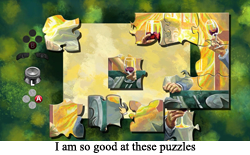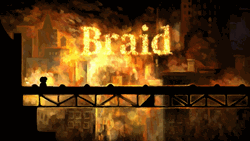 My esteemed colleague, BEAT the yelling skeleton-man, believes no one should purchase Braid, Anniversary Edition. While we generally agree on many matters, it has come to my attention that we have very separate opinions on this topic. As such, I will be addressing his assessment of Braid on a point-by-point basis. Luckily, BEAT was kind enough to provide a summary of his opinions via a document titled “IMMA DISCOURSE ALL OVER THIS MOTHERFUCKER.txt”, so we shall reference that text directly going forward. The first point…
My esteemed colleague, BEAT the yelling skeleton-man, believes no one should purchase Braid, Anniversary Edition. While we generally agree on many matters, it has come to my attention that we have very separate opinions on this topic. As such, I will be addressing his assessment of Braid on a point-by-point basis. Luckily, BEAT was kind enough to provide a summary of his opinions via a document titled “IMMA DISCOURSE ALL OVER THIS MOTHERFUCKER.txt”, so we shall reference that text directly going forward. The first point…
SEPARATING ART FROM ARTIST
· MANY PEOPLE SAY DO THAT. ARE THEY DUMB?
· DEATH OF THE AUTHOR V.S. MURDER OF THE AUTHOR
Braid is primarily seen as the progenitor of the “indie platformer” genre. The world of 2008 was a very different place for videogames. We had what we currently identify as “AAA games”, and we had… nothing else. Alright, that is a bit of an exaggeration, but the world of gaming was basically “big games go on consoles, little games go on handhelds.” So, while the Gameboy Advance and Nintendo DS produced some unbeatable masterpieces in their day, those “portables” were the only places you could find classic (and, not coincidentally, shorter) games like New Super Mario Bros. or practically the entire IGAvania library. Meanwhile, everything on consoles was $50-$60, and was expected to last you a solid fifty hours or so. And God help you if the graphics didn’t “push the Xbox to its limits”. Hell, the writing should have been on the wall when Nintendo Wii’s 2006 launch brought us Wii Sports. That was little more than a tech demo with graphics that were noticeably less impressive than its launch partner, The Legend of Zelda Twilight Princess, but anyone from that era can tell you which game saw more hours in the Wii. But that was the way of things! People loved Geometry Wars, but the 2005 release of the Xbox 360 was all about Gun, Perfect Dark Zero, and Dead or Alive 4. Kameo was somehow tremendously more important than a new way to play Joust or Gauntlet. And most readers right now are desperately googling to confirm whether I invented the concept of this “Kameo”!
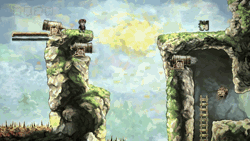 So 2008 was a watershed year. The big boys that were going to get all the headlines were Devil May Cry 4, Fable 2, Fallout 3, and Grand Theft Auto 4. There were games that were for different demographics, like Viva Piñata: Trouble in Paradise, but they were still considered to be on the same general “big game” echelon as Burnout: Paradise or Dead Space. Along comes Braid, a fifteen-dollar action puzzle game that is promoted as part of Microsoft’s Summer of Arcade. At a time when escaping physical media seemed like the ramblings of a madman (where would we store our beloved games? Some manner of cloud in the sky?), Microsoft deigned to promote its online store that directly sold games to customers (which may or may not have been vastly more profitable for the company than relying on Gamestop to push hardware). Braid wound up being the poster boy for this brave new world, and the rest was history. Braid became a “budget” action title at a time when that sort of thing did not exist outside of experimental ball-cleaning simulators. It sold like hotcakes. It was synonymous with modern gaming. And that may have impacted the author of the game, because, as my respected collaborator notes…
So 2008 was a watershed year. The big boys that were going to get all the headlines were Devil May Cry 4, Fable 2, Fallout 3, and Grand Theft Auto 4. There were games that were for different demographics, like Viva Piñata: Trouble in Paradise, but they were still considered to be on the same general “big game” echelon as Burnout: Paradise or Dead Space. Along comes Braid, a fifteen-dollar action puzzle game that is promoted as part of Microsoft’s Summer of Arcade. At a time when escaping physical media seemed like the ramblings of a madman (where would we store our beloved games? Some manner of cloud in the sky?), Microsoft deigned to promote its online store that directly sold games to customers (which may or may not have been vastly more profitable for the company than relying on Gamestop to push hardware). Braid wound up being the poster boy for this brave new world, and the rest was history. Braid became a “budget” action title at a time when that sort of thing did not exist outside of experimental ball-cleaning simulators. It sold like hotcakes. It was synonymous with modern gaming. And that may have impacted the author of the game, because, as my respected collaborator notes…
JONATHAN BLOW SURE SUCKS
· YOU COULD EVEN SAY HE… BLOWS.
· OHHHHHHHHHH GOTTEM
This is a tale as old as time, right? If Freddie Mercury had stuck to the degree in art and design he earned in ‘69, he might still be with us today. Similarly, Braid was a runaway success, so Jonathan Blow, its creator, became a videogame rockstar. He was not simply successful in the respect of being responsible for a bestselling game, he was the subject of multiple international news articles, featured in the New York Times, and was arguably the star of Indie Game: The Movie. I know (of) plenty of people that redefined gaming as we know it, and none of them got a damn movie! The rockstar comparison here is apt: there were a few solid years where Blow was treated like the God of Gaming, and everything from the release of the latest Grand Theft Auto or Mega Man 9 somehow required a comment from ol’ Jonathan.
And, unfortunately, Jonathan Blow’s comments have not been great over the years.
 Blow is known for Braid, which provided funding for his next game, The Witness. He is also responsible for Jai programming language, which was more or less a byproduct of the previous two creations. And that’s it! For this, he has been described as “a prickly genius”… and apparently “prickly” can be used interchangeably with “bigoted”. Also, just a head’s up: Blow is a “COVID truther”, so it should be illegal to classify him as a genius. In short, over the last two decades, Jonathan Blow has expressed many “opinions” that I will plainly state I personally find odious, and it bothers me that he has gotten thirty American dollars out of me over the years. It’s not much! But it is enough to leave a bad taste in my mouth.
Blow is known for Braid, which provided funding for his next game, The Witness. He is also responsible for Jai programming language, which was more or less a byproduct of the previous two creations. And that’s it! For this, he has been described as “a prickly genius”… and apparently “prickly” can be used interchangeably with “bigoted”. Also, just a head’s up: Blow is a “COVID truther”, so it should be illegal to classify him as a genius. In short, over the last two decades, Jonathan Blow has expressed many “opinions” that I will plainly state I personally find odious, and it bothers me that he has gotten thirty American dollars out of me over the years. It’s not much! But it is enough to leave a bad taste in my mouth.
So I agree with my revered acquaintance that Jonathan Blow “blows”. And that brings us neatly to our next point…
INTERACTIVITY AND AUTHORIAL INTENT
· NOBODY’S MAKING THAT ARGUMENT HERE IT’S NOT MINECRAFT
· THE BEAUTIFUL STORY OF A MAN DYING IN THE SAME PIT 50 TIMES
Once upon a time, there was a man named Notch aka Markus Persson. Notch created Minecraft. Minecraft became a (larger than Braid) hit, and was eventually sold to Microsoft. Now, Notch technically has nothing to do with Minecraft. That is ideal, because Notch is the kind of guy that identifies feminism as a “social disease” (his quote). But, as the “Minecraft came from space/Hatsune Miku” meme has proven, you do not need to know a lick about Notch to enjoy Minecraft. It is the videogame equivalent of Legos! And if you found out Legos were somehow invented by Hitler (note for lawyers: I am using this as a hypothetical, I am 100% plainly stating that Legos have nothing to do with Hitler. Unlike IBM) it would not impact a toddler’s enjoyment of the building blocks, as there is not much in the way of authorial intent involved with chunks of plastic. Notch’s Minecraft is by no means a story-driven experience, and the gameplay wholly supports death of the author.
But Braid does not have that excuse.
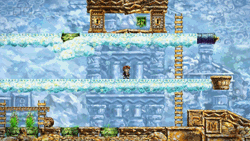 A thousand words in, let’s actually talk about the game of Braid. It is a 2-D action puzzle platformer. If that sequence of words is too esoteric, then let’s just call it Super Mario Bros. with time travel problems. You are Tim, a man searching for an unknown princess somewhere out in a fantasy world. In order to find this princess, Tim must solve a series of puzzles through wits and guile, and eventually collect an assortment of jigsaw pieces that will unlock the final castle. It’s Banjo-Kazooie. Give or take your amazing rewind and time-slow powers, this is a straightforward, “old school” adventure.
A thousand words in, let’s actually talk about the game of Braid. It is a 2-D action puzzle platformer. If that sequence of words is too esoteric, then let’s just call it Super Mario Bros. with time travel problems. You are Tim, a man searching for an unknown princess somewhere out in a fantasy world. In order to find this princess, Tim must solve a series of puzzles through wits and guile, and eventually collect an assortment of jigsaw pieces that will unlock the final castle. It’s Banjo-Kazooie. Give or take your amazing rewind and time-slow powers, this is a straightforward, “old school” adventure.
Except it very much is not. Over the course of the journey, you learn that there may be more to Tim’s adventure than meets the eye. Frequent references to alienation, alcoholism, and anxiety gradually paint Tim in an unfavorable light. This is all finally confirmed during the climax, when a deft bit of gameplay portrays Tim not as the brave protagonist attempting to rescue a princess, but a villain chasing a hapless maiden that wants nothing more than to be rid of her stalker. It is an extraordinary twist! It is easy to understand why Braid was lauded for revolutionary gameplay and story back in 2008.
But the story is just that: a story. There are effective moments of Braid where gameplay intersects with the “moral” of the story or level. Unfortunately, there are even more chunks of Braid that just talk at you. From the opening world, there are “books” that relay Tim’s tale. At the finale, there is an entire level’s worth of books and secret books that can only be read under specific conditions. And these books are no different from dialogue boxes in a Ninja Gaiden cutscene. So, as this story is relayed in a game with a single credited author, it is hard not to imagine the “books” as a conversation between Jonathan Blow and you, the player. He is sitting back in his rocking chair, telling you the chronicle of his totally-a-different-person friend, Tim, and you are intently listening to him spin his narrative. Maybe you agree with it. Maybe you do not. But it is impossible to separate this story from the author. And, as we covered a paragraph ago, this author has some other tales not worth telling…
Though this apparently brings us back to that opening “death of the author” suggestion from my admired associate. And, as such, it is likely a good idea to look forward to his next point…
VIDEO GAMES. ARE THEY ART?
· ART!
· -ART?
· “ART”
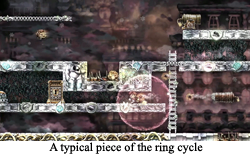 A significant reason Braid garnered so much praise was that it was considered an “art game”. And it is easy to understand why! Braid contains gorgeous art by David Hellman of A Lesson Is Learned But The Damage Is Irreversible, licensed music that would be at home in a videogame or on your winamp playlist, and a story about love and loss that could put Dickens to shame (Dickens is shamed in this case because someone remembered Barnaby Rudge). Take any individual piece of Braid, show it to the layman, and they will inevitably identify it as art. But can a videogame be art? Oh my God… Shut-up. Just shut-up. Videogames are art. End of story. It doesn’t matter if it was sixteen years ago or now, videogames are and have always been art.
A significant reason Braid garnered so much praise was that it was considered an “art game”. And it is easy to understand why! Braid contains gorgeous art by David Hellman of A Lesson Is Learned But The Damage Is Irreversible, licensed music that would be at home in a videogame or on your winamp playlist, and a story about love and loss that could put Dickens to shame (Dickens is shamed in this case because someone remembered Barnaby Rudge). Take any individual piece of Braid, show it to the layman, and they will inevitably identify it as art. But can a videogame be art? Oh my God… Shut-up. Just shut-up. Videogames are art. End of story. It doesn’t matter if it was sixteen years ago or now, videogames are and have always been art.
But “art” does not mean “perfect”. In fact, art is often messy and chaotic. And Braid is definitely messy. For all the comp sci major talk surrounding Braid, it is an extremely finicky game, with many puzzles that are solved through a combination of thinking and far too much physical prowess/luck. Slow time and reverse a switch to climb a ladder while it gradually falls… assuming your lil’ Tim is going to properly bounce off and collect the jiggy you need. If not, you could “know” how to solve the puzzle, be doing everything just a degree off from “right”, and fail enough times that you think you need an entirely different solution. And that kind of imprecision is poison to an action platforming puzzle! Tim is never going to bother that princess now!
But even more than that, there is a significant chunk of “art nonsense” included with Braid. As many people know through incalculable Braid osmosis, there are a series of “hidden stars” lurking around Braid. These are difficult to obtain, and some can be permanently missable if you solve the game in a natural, linear fashion. And one requires multiple hours of standing perfectly still. But if you complete these cryptic challenges, you will discover the secret of Braid’s story is that it is not a story of boy stalks girl, but a tale of the invention of the atom bomb. Or… something. Look, we are all sons of bitches, and the only way to truly conquer Braid is to become (bored to) death. This whole tangent (the game’s tangent, not my own desperate flailing in this paragraph) is like any literary risk: if it works, the audience is enriched by the diverging narrative. Unfortunately, I have never met a single person that has done anything but deride or mock this late game curveball, so the whole constellation ending can confidently be declared a swing and a miss.
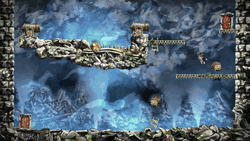 But that’s art! Sometimes it works, and sometimes it decisively does not. And the fact that Braid is declared “genius” when its contemporary Mega Man 9 (featuring Concrete Man!) does not earn the same accolade is the fault of a capricious audience. But regardless, Jonathan Blow’s Braid is an artistic centerpiece of its time, and is worth a second look in 2024.
But that’s art! Sometimes it works, and sometimes it decisively does not. And the fact that Braid is declared “genius” when its contemporary Mega Man 9 (featuring Concrete Man!) does not earn the same accolade is the fault of a capricious audience. But regardless, Jonathan Blow’s Braid is an artistic centerpiece of its time, and is worth a second look in 2024.
Of course, that does bring us back to the matter of whether or not you should purchase a copy of Braid, Anniversary Edition. While I will begrudgingly give an additional payday to Jonathan Blow in the name of reliving a beloved game from my past, my esteemed colleague believes this is the answer:
YOU ALREADY OWN BRAID WHY BUY IT AGAIN.
· QUIT LYING. IT’S IN YOUR STEAM LIBRARY.
· IT’S BEEN THERE SINCE 2010.
Oh yeah. Everybody does already own Braid. Guess you don’t really need to do that kind of thing twice…
FGC #675 Braid, Anniversary Edition
- System: Braid, Anniversary Edition is currently available for goddamned everything. The first Google result is not Wikipedia, but the Apple Store. Do you know how rarely that happens with games on this site?
- Number of Players: Has there ever been a multiplayer platforming puzzle game? Other than Trine? This one is single player.
- Watch it, Buddy: As you may already be aware, this article was inspired by an evening of Even Worse Streams playing Braid, and BEAT having a lot to say about it. You can watch it!
August 6, 2024Participants include the aforementioned BEAT, fanboymaster, Caliscrub, AJ Vark, Trynant, Chromes, Cassandralyn, and me piloting the controller. Includes bonus fanart of things that have nothing to do with Braid!
- Featured Art: Speaking of Chromes, he provided some fan art of our horrifying protagonist, Tim!

Click for the full size version
I think he am become death or some such thing. Find more on Chromes and his art here. - No Comment: So the selling point of Braid, Anniversary Edition is that it includes “15 hours of commentary”. For a game that can easily be completed in three hours, this advert should be treated as a threat. Fortunately, the Braid, Anniversary Edition team found an excellent way to organize the commentary, and you can focus on particular subjects and levels as to accommodate your own interests. Find out more about popular Braid topics like level design, art, music, and Soulja Boy. On the flipside, commentary chunks can talk about individual stages for 3-5 minutes, which seems disproportionate when some stages can be knocked out in about thirty seconds. Also…
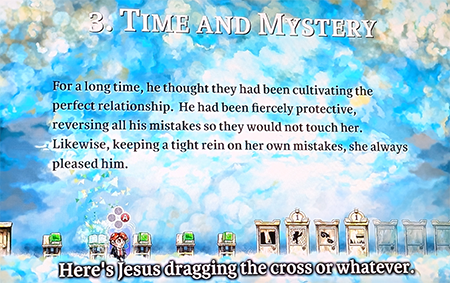
This somehow happens. Moreover, Blow takes time out of his day to obliquely disparage Cave Story, and that is unforgivable.
- Favorite Commentary Quote: “It feels like ideas, right?” – Jonathan Blow.
- Favorite Gimmick: A weird design issue with Braid is that “rewind” is so good, everything else is gilding the lily. Quantum-Shadow Tim and Slow-Mo Ring are both cool, but after a few worlds of “just” rewind, it feels like someone was desperately reaching for new gimmicks after running out of ideas. And there are so many rewind applications available! Ask that prince from Persia!
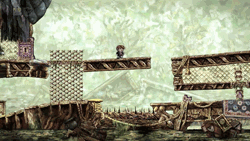 Just play the gig, man: I have had Jami Sieber’s “Play it by Heart” on my playlist since the absolute first moment I heard the song. How is that ditty so perfect for puzzle platforming? It shouldn’t be possible!
Just play the gig, man: I have had Jami Sieber’s “Play it by Heart” on my playlist since the absolute first moment I heard the song. How is that ditty so perfect for puzzle platforming? It shouldn’t be possible!- Did you know? God, if this were a just world, A Lesson Is Learned But The Damage Is Irreversible would have the cultural clout of Braid, and I would have a hardbound anniversary edition omnibus of that on my bookshelf.
- Would I play again: Being able to experience an old favorite with friends was a great way to replay Braid. And I’m probably good to not do that again for a long, long while. See you again come Braid, 30th Anniversary Edition!
What’s next? Random ROB has chosen… Castlevania Dominus Collection! Because it’s Halloween! Or thereabouts! Get ready to slay some skeletons! Please look forward to it!
